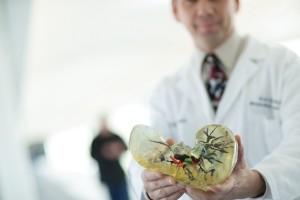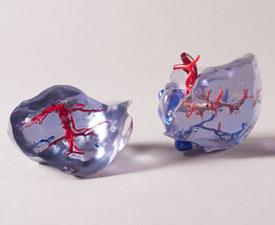Every city has its points of pride, and, when you’re a Rust Belt town with a rough history, those points of pride become huge. I was born and raised in Cleveland, Ohio and its surrounding areas, and I’ve watched the city evolve from the “mistake on the lake” to one of the country’s top cities for arts and entertainment, food and drink, and medicine. The Cleveland Clinic attracts patients from around the world, patients who, without the world-class doctors and highly specialized, advanced medical technology the Clinic offers, would have little or no hope. The hospital, which was just ranked as the 5th top hospital in the country, is best known for its cardiology department, but it also has the distinction of having creating the first 3D printed liver.
 In 2012, Cleveland Clinic Chief of Hepatology Dr. Nizar Zein discovered 3D printing. While reading about its uses and applications, he began to consider how the technology could be used in medicine, particularly in risky liver surgeries. The complexity of the liver meant that surgeons sometimes accidentally cut through major blood vessels or bile ducts, causing dangerous complications for the patients. At that time, 3D models of organs were being studied on computer screens, but it was still difficult to get a feel for the depth and scale of the organs. With a printed model, Dr. Zein thought, the surgeons’ proximity to blood vessels and bile ducts could be safely double checked.
In 2012, Cleveland Clinic Chief of Hepatology Dr. Nizar Zein discovered 3D printing. While reading about its uses and applications, he began to consider how the technology could be used in medicine, particularly in risky liver surgeries. The complexity of the liver meant that surgeons sometimes accidentally cut through major blood vessels or bile ducts, causing dangerous complications for the patients. At that time, 3D models of organs were being studied on computer screens, but it was still difficult to get a feel for the depth and scale of the organs. With a printed model, Dr. Zein thought, the surgeons’ proximity to blood vessels and bile ducts could be safely double checked.
Currently, 3D printing models of patients’ organs is becoming a pretty common and easy practice that is being used in an increasing variety of surgeries. At the time, however, it was still very experimental and required a lot of testing.
“We went through a process for every patient who underwent liver surgery where we resected a portion of the liver, took it out, [and] prior to surgery, we prepared a 3D printed version of it,” said Dr. Zein.
 Dr. Zein believes that the 2012 trials resulted in the first-ever 3D printed liver. At that time, it took six weeks to print, which seems incredible when you consider how fast 3D printers are today, only three years later. Now, the hospital can print a replica liver in less than 48 hours. As 3D printing technology has improved, so have the models the hospital is able to print. The early models were yellowish and hazy, but now they are as clear as glass, enabling doctors to easily see blood vessels and bile ducts. In 2014, the hospital was using the models regularly during surgeries, and they’ve continued to improve. Different components can be printed individually, removed from the model for closer examination, and then replaced within the larger organ model using a series of magnets. At this point, Zein has printed over 20 liver models.
Dr. Zein believes that the 2012 trials resulted in the first-ever 3D printed liver. At that time, it took six weeks to print, which seems incredible when you consider how fast 3D printers are today, only three years later. Now, the hospital can print a replica liver in less than 48 hours. As 3D printing technology has improved, so have the models the hospital is able to print. The early models were yellowish and hazy, but now they are as clear as glass, enabling doctors to easily see blood vessels and bile ducts. In 2014, the hospital was using the models regularly during surgeries, and they’ve continued to improve. Different components can be printed individually, removed from the model for closer examination, and then replaced within the larger organ model using a series of magnets. At this point, Zein has printed over 20 liver models.
Having perfected the method of 3D liver modeling, the clinic was able to offer hope to a patient with a liver tumor who had already been turned down by other hospitals. Dr. Zein is thrilled with the possibilities that 3D printing offers for saving lives that could not have been saved before.
“My career has been as a clinical investigator so medical research and investigation is part of my life and it’s probably the most exciting part of my life,” he said. “So I’m very proud of what we did. What comes out of it, in the end, I’m not sure, but I have a feeling that there will be a role for these technologies, 3D printing, in complex surgeries.”
Subscribe to Our Email Newsletter
Stay up-to-date on all the latest news from the 3D printing industry and receive information and offers from third party vendors.
You May Also Like
Further Understanding of 3D Printing Design at ADDITIV Design World
ADDITIV is back once again! This time, the virtual platform for additive manufacturing will be holding the first-ever edition of ADDITIV Design World on May 23rd from 9:00 AM –...
3D Printer Maker EVO-tech Reborn as NEVO3D — Once More With Feeling
EVO-tech was a 3D printing service and original equipment manufacturer established in 2013 and based in Schörfling am Attersee, Austria. The company produced high-quality material extrusion systems featuring linear bearings,...
3D Systems Brings 3D Printed PEEK Cranial Implant to the U.S. with FDA Clearance
For more than 10 years, 3D Systems (NYSE:DDD) has worked hand-in-hand with surgeons to plan over 150,000 patient-specific cases, and develop more than two million instruments and implants from its...
CDFAM Returns to Berlin for Second Annual Symposium
The second CDFAM Computational Design Symposium is scheduled for May 7-8, 2024, in Berlin, and will convene leading experts in computational design across all scales. Building upon the first event...

































